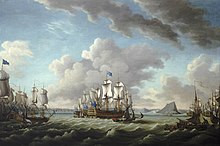William Domett
Sir William Domett | |
|---|---|
Knight Grand Cross of the Order of the Bath |
Early career
Little is known of Domett's birth or upbring, although it is thought he was born in the Hawkchurch, Devon region in 1752.[1] The first solid record of him available was in 1769, when he joined the Navy and appears on the muster books of HMS Quebec, under the patronage of Captain Alexander Hood. Domett spent the next five and a half years in the Mediterranean Sea, leaving Quebec in 1772 and joining HMS Scorpion. In 1775, Domett was briefly attached to HMS Marlborough before joining HMS Surprize on the Newfoundland Station at the start of the American Revolutionary War.[1]
At the outbreak of the Revolutionary War, Domett was in Surprise when she was at the relief of the
Three years later, Domett was still aboard Robust, and in her took part in the

As a captain, Domett was immediately requested by Alexander Hood to be his flag captain in HMS Queen. On board this ship Domett saw out the war, joining Lord Howe's fleet which relieved the Great Siege of Gibraltar and later fought at the Battle of Cape Spartel. The end of the war saw Domett, with many other officers, unemployed and on half-pay.[1]
French Revolutionary and Napoleonic Wars
Domett's close ties with the Hood family meant that he had good connections, and so in 1786, Domett was given the 24-gun HMS Champion at Leith. Several years later, Domett moved to HMS Pomone and conducted a year long cruise down the coast of West Africa and through the West Indies. On his return, Domett was requested by Admiral Mark Milbanke for service in Newfoundland on HMS Salisbury but in 1790 Domett was back in Britain as Hood's captain on HMS London during the Spanish armament.[1] When this emergency died down, Domett took command of HMS Pegasus and then later he took command of HMS Romney, a ship he had served aboard as a lieutenant, before returning to Hood's service as captain of HMS Royal George in 1803 at the outbreak of the Napoleonic Wars.[1]
Royal George was second flagship of the Channel Fleet, and Lord Howe its overall commander. In 1794, Lord Howe embarked on the Atlantic campaign of May 1794, which ended in the Glorious First of June, at which Domett and Royal George were heavily engaged and the ship badly damaged. Domett remained in command when Hood became Viscount Bridport and served under him again the following year at the Battle of Groix. Domett did not leave Royal George until 1800, the seven years he spent in command being a record in the Channel Fleet at the time.[1]
When
At the
Retirement
The
Domett was made a Knight Commander of the Order of the Bath on 2 January 1815,[1] promoted to full admiral on 12 August 1819[7] and advanced to Knight Grand Cross of the Order of the Bath on 16 May 1820.[1] Domett settled on his estate in Hawkchurch, Devon near the home of Lord Bridport, who had died in 1814.[1] He never married and had no children, but was highly esteemed in the service as a consummate sailor and brave fighter whose extremely long and dedicated sea service had earned him an excellent reputation in the Navy.[1] He died suddenly in 1828 and was buried in the local church.[1]
References
- ^ Oxford Dictionary of National Biography, P. K. Crimmin, retrieved 5 February 2008
- ^ David Syrett & R.L. DiNardo (Eds.) The commissioned sea officers of the Royal Navy 1660-1815, Scholar Press for the Navy Records Society, 1994, p.127
- ^ "No. 15695". The London Gazette. 21 April 1804. p. 496.
- ^ "Sainty, JC, Lord High Admiral and Commissioners of the Admiralty 1660–1870, Office-Holders in Modern Britain: Volume 4: Admiralty Officials 1660–1870 (1975), pp. 18–31". Retrieved 4 September 2009.
- ^ Rodger, p. 69
- ^ "No. 16309". The London Gazette. 24 October 1809. p. 1685.
- ^ "No. 17505". The London Gazette. 12 August 1819. p. 1446.
Sources
- "Domett, William". doi:10.1093/ref:odnb/7787. (Subscription or UK public library membershiprequired.)
- Rodger, N.A.M. (1979). The Admiralty. Offices of State. Lavenham: T. Dalton Ltd. ISBN 0900963948.

